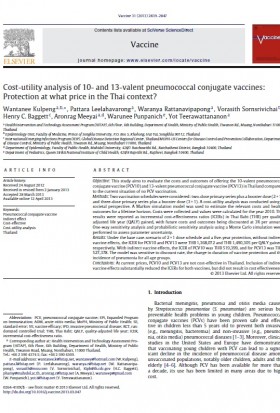This website uses cookies so that we can provide you with the best user experience possible. Cookie information is stored in your browser and performs functions such as recognising you when you return to our website and helping our team to understand which sections of the website you find most interesting and useful.
Cost-utility analysis of 10- and 13-valent pneumococcal conjugate vaccines: Protection at what price in the Thai context? (2013)

รายละเอียดเพิ่มเติม
Cost-utility analysis of 10- and 13-valent pneumococcal conjugate vaccines: Protection at what price in the Thai context?
Wantanee Kulpenga, b, , , , Pattara Leelahavaronga, , Waranya Rattanavipaponga, , Vorasith Sornsrivichaib, , Henry C. Baggettc, , Aronrag Meeyaia, d, , , Warunee Punpaniche, , Yot Teerawattananona,
a Health Intervention and Technology Assessment Program (HITAP), 6th Floor, 6th Building, Department of Health, Ministry of Public Health, Tiwanon Rd., Muang, Nonthaburi 11000, Thailand
b Epidemiology Unit, Faculty of Medicine, Prince of Songkla University, P.O. Box 5, Khohong, Hat Yai, Songkhla 90112, Thailand
c International Emerging Infections Program (IEIP), Global Disease Detection Regional Center, Thailand MOPH-US Centers for Disease Control and Prevention Collaboration, Department of Disease Control, Ministry of Public Health, Tiwanon Rd., Muang, Nonthaburi 11000, Thailand
d Department of Epidemiology, Faculty of Public Health, Mahidol University, 420/1 Ratchawithi Rd., Ratchathewi District, Bangkok 10400, Thailand
e Department of Pediatrics, Queen Sirikit National Institute of Child Health, 420/8 Rajvithi Rd., Rajthevi, Bangkok 10400, Thailand
Abstract
Objective
This study aims to evaluate the costs and outcomes of offering the 10-valent pneumococcal conjugate vaccine (PCV10) and 13-valent pneumococcal conjugate vaccine (PCV13) in Thailand compared to the current situation of no PCV vaccination.
Methods
Two vaccination schedules were considered: two-dose primary series plus a booster dose (2 + 1) and three-dose primary series plus a booster dose (3 + 1). A cost-utility analysis was conducted using a societal perspective. A Markov simulation model was used to estimate the relevant costs and health outcomes for a lifetime horizon. Costs were collected and values were calculated for the year 2010. The results were reported as incremental cost-effectiveness ratios (ICERs) in Thai Baht (THB) per quality adjusted life year (QALY) gained, with future costs and outcomes being discounted at 3% per annum. One-way sensitivity analysis and probabilistic sensitivity analysis using a Monte Carlo simulation were performed to assess parameter uncertainty.
Results
Under the base case-scenario of 2 + 1 dose schedule and a five-year protection, without indirect vaccine effects, the ICER for PCV10 and PCV13 were THB 1,368,072 and THB 1,490,305 per QALY gained, respectively. With indirect vaccine effects, the ICER of PCV10 was THB 519,399, and for PCV13 was THB 527,378. The model was sensitive to discount rate, the change in duration of vaccine protection and the incidence of pneumonia for all age groups.
Conclusions
At current prices, PCV10 and PCV13 are not cost-effective in Thailand. Inclusion of indirect vaccine effects substantially reduced the ICERs for both vaccines, but did not result in cost effectiveness.
Abbreviations
PCV, pneumococcal conjugate vaccine; EPI, Expanded Program on Immunization; AOM, acute otitis media; MoPH, Ministry of Public Health; SE, standard error; VE, vaccine efficacy; IPD, invasive pneumococcal disease; RCT, randomized controlled trial; THB, Thai Baht; QALY, quality-adjusted life year; ICER, incremental cost-effectiveness ratio
Full Text: http://www.sciencedirect.com/science/article/pii/S0264410X13003939




